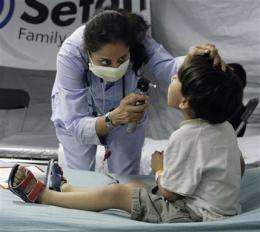McTriage: Hospitals use drive-thrus for swine flu

(AP) -- Fast-food places have them. Banks and pharmacies do, too. Now hospitals are opening drive-thrus and drive-up tent clinics to screen and treat a swelling tide of swine flu patients.
Call it McTriage. And yes, you can get Tamiflu with that - if you're sick enough to need it. Most people aren't.
The idea behind these efforts is to keep coughing, feverish people out of regular emergency rooms, where they can infect heart attack victims and other very sick patients. The need has soared in recent weeks as flu has spread among schoolchildren before vaccine is available.
In Austin, Texas, Dell Children's Medical Center had nearly 400 ER visits on Sunday alone, mostly kids with swine flu. Dozens were diverted to two tents outside, and there are plans to add a third.
In Memphis, Tenn., Le Bonheur (pronounced luh-BAHN-uhr) Children's Hospital has had more than 5,500 kids with flu-like illness seek emergency care since Aug. 1. The hospital set up tents outside its ER on Sept. 11 and already has treated more than 900 cases in them.
Hope and Billy Howard took their 3-year-old daughter, Emma Smith, to one on Sunday. The little girl had a fever that would not break with over-the-counter medicine, complained of belly pain and refused to eat, and her parents could not reach her pediatrician.
"I didn't know what to give her, and I didn't want to take any chances," her mother said. At the tent ER, "we were in and out in 15 minutes."
Entire families who are sick have shown up at Bayne-Jones Army Community Hospital in Fort Polk, La., near the Texas state line.
"They just drive up in their pajamas," said Henry Johnson, a physician's assistant who helped start a tent system there. People pull up, park and go through three tents, where they undergo an exam that includes having their temperature taken. They are usually sent home, with prescriptions if needed.
"It's working out for us - nothing but rave reviews," he said.
Very few patients have needed to be admitted, doctors running these programs say.
Jim Bentley, policy chief at the American Hospital Association, said many hospitals are trying novel ways to care for more people than their emergency rooms can handle, especially children.
"You're dealing often with anxious patients who want to know is it OK to care for them at home" versus the hospital, he said. "One thing a tent offers is a less intimidating atmosphere to the child," as opposed to an emergency room with its beeps and other noises and scary trauma cases, he said.
These programs can be part of disaster plans that each hospital must have, said Dr. Pat Crocker, chief of emergency medicine at Dell Children's in Austin.
"It's working great for flu, but it can be a model for hospitals all over the country to use for emergency surge capacity for other things," such as natural disasters or explosions, he said.
Under a program at Stanford University in Palo Alto, Calif., many flu patients will not even have to leave their cars.
Stanford Hospitals and Clinics and Lucille Packard Children's Hospital share an ER, and recently tested a drive-thru system for flu patients in a parking ramp. Forty Red Cross volunteers played the parts of actual patients who sought emergency care in April and May, when swine flu first emerged.
Doctors in the drive-thru drill correctly "admitted" the six volunteers who needed to be hospitalized, and correctly sent the 34 others home, said Dr. Eric Weiss, medical director of disaster planning for the hospitals.
The drive-thru shaved 80 minutes off the typical two-hour wait in the regular emergency room. The plan is to put it into action whenever swine flu patients swamp the ER.
It works like this:
A nurse near the ER stops cars and sends appropriate cases to the drive-thru. Signs tell families to tune the radio to a public broadcasting station that describes what happens next.
"The patient's automobile acts as a self-contained isolation compartment, a moving exam room," Weiss said. "The hoods of the cars make excellent places to write notes," and medical records are slid under the windshield wipers.
Through the car window, a doctor uses a device that clips on a finger to measure blood pressure, pulse and breathing rates. Fingerstick blood tests can be done.
In nearby tents, diabetics can get a urine test for blood sugar, and heart patients can get an EKG. Portable X-rays are available, too. The last stop has a pharmacy to get vaccine, medicines or a prescription to fill.
Weiss has a grant to develop a handout of the plan to give to other hospitals and recently described it at a California Hospital Association meeting.
All hospitals must find ways to handle the crush of swine flu patients, Weiss said.
"When all of these people start showing up in emergency departments, we're going to lose our safety net pretty quickly," he said. "We can't have our ERs completely overwhelmed with patients with infectious diseases."
---
On the Net:
Flu advice: www.flu.gov
Flu versus colds: www.cdc.gov/flu/about/qa/coldflu.htm
Stanford's drive-thru drill: news.stanford.edu/news/2009/june17/videos/545.html
©2009 The Associated Press. All rights reserved. This material may not be published, broadcast, rewritten or redistributed.



















